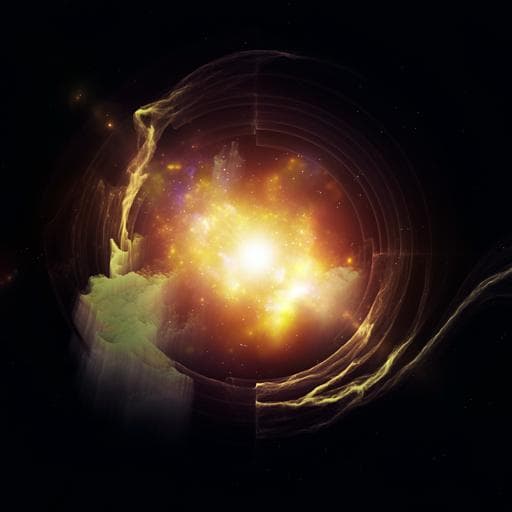
Physics
A portrait of the Higgs boson by the CMS experiment ten years after the discovery
T. C. Collaboration
Ten years after its discovery, the CMS Collaboration delves deep into the Higgs boson, observing its properties across multiple decay channels and reaffirming its alignment with Standard Model predictions. As research continues with high-luminosity LHC data, the quest to uncover the Higgs sector's mysteries intensifies!
~3 min • Beginner • English
Introduction
The paper addresses how precisely the properties of the Higgs boson, discovered in 2012, agree with the predictions of the Standard Model (SM) and what constraints can be placed on possible physics beyond the SM (BSM) via the Higgs sector. It reviews the theoretical context: the SM unifies electromagnetic, weak, and strong interactions; the Brout–Englert–Higgs (BEH) mechanism introduces a scalar field whose quantum excitation is the Higgs boson, providing masses to W and Z bosons and, via Yukawa interactions, to fermions. Following the discovery of W and Z bosons in 1983 and the Higgs boson in 2012, a major goal is precision characterization of Higgs production and decay, including its couplings and potential self-interactions. Challenges arise from quantum corrections to scalar masses (naturalness) and the large mass of the Higgs relative to the electroweak scale. The study aims to combine CMS Run 2 results to measure production cross-sections, branching fractions, coupling modifiers, and limits on Higgs boson pair production, and to compare them to SM predictions.
Literature Review
The paper summarizes the historical development of the Higgs mechanism and the SM: BEH mechanism proposals in 1964 (Brout–Englert, Higgs, Guralnik–Hagen–Kibble), refinements by Higgs (1966) and Kibble (1967), electroweak unification by Weinberg and Salam building on Glashow’s work, and proof of renormalizability by ’t Hooft and Veltman (1971–72). Experimental milestones include the discovery of W and Z bosons at CERN (UA1/UA2, 1983), extensive Higgs searches at LEP and the Tevatron, and the Higgs discovery by ATLAS and CMS in 2012. The LHC Higgs Cross Section Working Group provided increasingly precise theoretical predictions (inclusive, differential, and properties handbooks). Prior CMS measurements established bosonic and fermionic decays, spin-parity J^P = 0^+, and production modes in Run 1, laying the groundwork for Run 2 precision studies. The paper cites numerous CMS analyses for individual channels and combined results, as well as recent theoretical calculations for single and double Higgs production at higher orders in perturbation theory.
Methodology
- Detector and datasets: The CMS detector is a multipurpose, nearly hermetic apparatus with silicon tracking, electromagnetic (ECAL) and hadronic calorimetry (HCAL) inside a 3.8 T solenoid, and muon detectors. Particle-flow reconstruction is used to identify electrons, muons, tau leptons, photons, jets, and missing transverse momentum (p_miss). Data correspond to proton-proton collisions at √s = 13 TeV during LHC Run 2 (2016–2018) with an integrated luminosity up to 138 fb⁻¹ (about 8 million Higgs bosons produced). Improvements since 2012 include enhanced calibration, alignment, triggers, and reconstruction, reducing statistical and systematic uncertainties.
- Analysis strategy: Channels are mutually exclusive by design to avoid overlap. Events are categorized by production signatures (e.g., VBF-like with two high-pT jets; VH with additional leptons and/or p_miss; ttH/tH with b-tagged jets; ggH otherwise) and by kinematic properties and mass resolution. Decay channels included: H → γγ; H → ZZ → 4ℓ; H → WW; H → Zγ; H → ττ; H → bb; H → μμ; ttH and tH with multileptons; and searches for BSM decays (including invisible).
- Statistical procedure: A global likelihood is built from all input categories with full treatment of correlations among systematic uncertainties (experimental and theoretical). Parameter estimation and limit setting use the profile likelihood method with asymptotic approximations. Nuisance parameters associated with common effects (e.g., theory modeling, object energy scales) are correlated across channels and years; the inclusive signal-strength combination includes O(10^4) nuisance parameters.
- Measurement frameworks: The μ-framework fits signal-strength parameters μ = σ/σ_SM (for production) and μ′ = B/B_SM (for decay) to quantify deviations from the SM-normalized yields. The κ-framework fits coupling modifiers κ_i that scale the Higgs couplings to vector bosons and fermions, and effective modifiers for loop-induced processes (κ_g, κ_γ, κ_Zγ). For Higgs boson pair production (HH), limits are set on σ(pp → HH) relative to the SM and on the self-coupling modifier κ_λ and quartic VVHH coupling modifier κ_λν, exploiting multiple exclusive final states and their combination.
Key Findings
- Global compatibility with the SM: A common signal-strength fit yields μ = 1.002 ± 0.057, in excellent agreement with the SM and about 4.5 times more precise than at discovery. Contributions to the uncertainty are of similar magnitude from theoretical (0.036), statistical (0.029), and experimental systematic (0.033) sources.
- Mass and width: The Higgs boson mass is measured as m_H = 125.38 ± 0.14 GeV using H → γγ and H → ZZ* → 4ℓ. The Higgs width extracted using on- and off-shell production is Γ ≈ 3.2 MeV.
- Production and decay observations: With Run 2 data, CMS observes H → ττ at 5.9 s.d., H → bb at 5.6 s.d., and ttH production at 5.2 s.d.; H → μμ is seen at 3 s.d. All major single-Higgs production modes (ggH, VBF, WH, ZH, ttH) are observed with ≥5 s.d. significance in the combined fits. Fits of signal strengths by production mode and by decay channel are statistically consistent with the SM (P-values ≈ 3.1% and 30.1%, respectively).
- Cross-sections and branching: For m_H = 125.38 GeV at √s = 13 TeV, the SM total Higgs production cross-section is 54 ± 2.6 pb, implying roughly one Higgs boson per second at instantaneous luminosity 2×10^34 cm⁻² s⁻¹. The dominant production is ggH (~87%), followed by VBF and associated modes.
- Coupling modifiers: Fits in the κ-framework constrain couplings to vector bosons and fermions at the ~10% level (with κ_t and κ_b at ~20% and κ_Zγ at ~40% uncertainty). All are consistent with κ = 1 within about 1.5 s.d. The pattern of couplings versus particle mass agrees with the BEH mechanism over three orders of magnitude.
- Invisible and exotic decays: Dedicated searches set B_inv < 0.16 at 95% CL for invisible Higgs decays.
- Higgs pair production: The nonresonant HH production cross-section is constrained to be less than 3.4 times the SM prediction at 95% CL, combining all studied final states. Constraints on self and quartic couplings from HH: κ_λ ∈ [−1.24, 6.49] and κ_λν ∈ [0.67, 1.38] at 95% CL; κ_λν = 0 is excluded at 6.6 s.d., establishing the existence of the VVHH quartic coupling in the assumed framework.
- Projections: HL-LHC (3,000 fb⁻¹ at 14 TeV) is expected to achieve sensitivity below the SM HH rate (expected combined limit < 1), enabling observation of SM HH production, and to markedly improve precision on κ modifiers and rare decays (e.g., H → μμ, H → Zγ).
Discussion
The comprehensive CMS Run 2 combination shows that Higgs boson production and decay rates across multiple channels are aligned with SM expectations, strengthening the BEH mechanism’s prediction that couplings scale with particle masses. The precise μ and κ fits indicate no significant deviations, constraining broad classes of BSM scenarios that would alter loop-induced or tree-level couplings. The observation of fermionic decays (to b quarks and τ leptons) and evidence in muons confirm Yukawa interactions across generations. The stringent combined limits on HH production and on κ_λ and κ_λν probe the Higgs self-interaction and quartic VVHH coupling, key parameters of the scalar potential; the destructive interference pattern and kinematic dependence underscore the challenge of HH searches with current luminosity. Limits on invisible branching constrain models with light new states coupling to the Higgs. Overall, the results substantially narrow the space for deviations while leaving room for effects at smaller magnitudes that require higher precision and larger datasets to uncover.
Conclusion
This paper delivers the most precise CMS portrait of the Higgs boson to date using up to 138 fb⁻¹ at 13 TeV. The global signal strength (μ = 1.002 ± 0.057), observed production modes at high significance, precise mass determination, and coupling modifier fits all support the SM description of the Higgs sector, including the scalar nature and mass-proportional couplings to fermions and vector bosons. The combined limits on Higgs pair production approach twice the SM expectation, providing meaningful constraints on the Higgs self-coupling and quartic VVHH coupling. Looking ahead, increased luminosity and improved analysis and theoretical methods at the HL-LHC are expected to establish SM HH production (~4 s.d.), improve measurements of rare decays (H → μμ, H → Zγ), access the charm Yukawa coupling, and extend searches for exotic and invisible decays, thereby enhancing sensitivity to BSM effects in the Higgs sector.
Limitations
- Sensitivity to Higgs boson pair production remains limited by small cross-sections and destructive interference effects, necessitating much larger datasets for observation and precise self-coupling measurements.
- Some coupling measurements (e.g., κ_t, κ_b, κ_Zγ) still carry relatively large uncertainties compared with others, with statistical and systematic components of similar size.
- The bbH production mode is not studied in the SM context due to limited sensitivity.
- Results rely on theoretical inputs (cross-sections, branching fractions) that contribute non-negligible uncertainties; correlations and modeling systematics are complex and can limit precision.
- Constraints on rare decays and certain second-generation couplings (e.g., charm) are not yet at the sensitivity required for definitive measurements.
Related Publications
Explore these studies to deepen your understanding of the subject.







